One day in late April, I took a midmorning walk down the river path that swings around behind the building where I work. The sun was having a spring affair with the sweep of white clouds marbling the sky. At a break in the trees along the river, after gazing at the Chartreuse massif robed in clouds and some cormorants meditating on a snag, I looked back upriver and saw an ethereal vision the distance: a single tree crowning a verdant hill, set apart by glowing curtains of mist and so clarified by the sun that I could have reached out and plucked it right off the Arthurian hilltop. Though I had never seen the tree before, I realized I knew its name: Le Chêne de Venon. One of my coworkers, making recommendations about local walks, had told me about “this famous old oak tree on a hill by a village that you can walk to from here,” and waved in that general direction. I had to be looking at that iconic tree.
This weekend, I finally sat in the June shade of the “8ème merveille du Dauphiné”1 and looked down at the bend in the river where I was when I first saw it. The hour-long hike was a small study in the ancient urban-alpine ecotone that is sunk so deep into the seams of the Alps. It took us from a bus stop on the valley floor, up a series of steep woodland switchbacks, along wheatfields jangling with cowbells, through villages of medieval-looking mud-and-stone barns and tidy cottages, and up the green hill to the venerable tree. On our return we walked through a string of villages that I’m fairly certain I can see from my front door when I look down the avenue that runs straight to the foothills. The church tower and scatter of quaint houses settled in the foreground of the imposing snow-capped Belledonne range is one thing that sets this view apart from the American Rockies: the gentle, indelible, inextricable human touch.2
The woodland: The leading edges of the Belledonne foothills are swathed in dappled beech shade, sheltering the approach to the pastures and villages carved into the hilltops above. I don’t know the history of these patches of woodland, if they were left because the land was too steep or too north-facing to cultivate or because they sheltered game, if they were harvested and replanted, if they’re privately owned, even whether or not they’re legally protected now. I hope I’ll learn that history while I’m here. For now, I follow the public footpath through the trees, admiring light seeping through leaves and around trunks, scatters of understory wildflowers and fungi. It feels wild, but it’s not long before the switchback brushes the edge of a field, an irrigation ditch burbling along the border and a bridge over into the pasture where a farmer is cutting grass, or a local road where a tractor is hauling bales of hay.

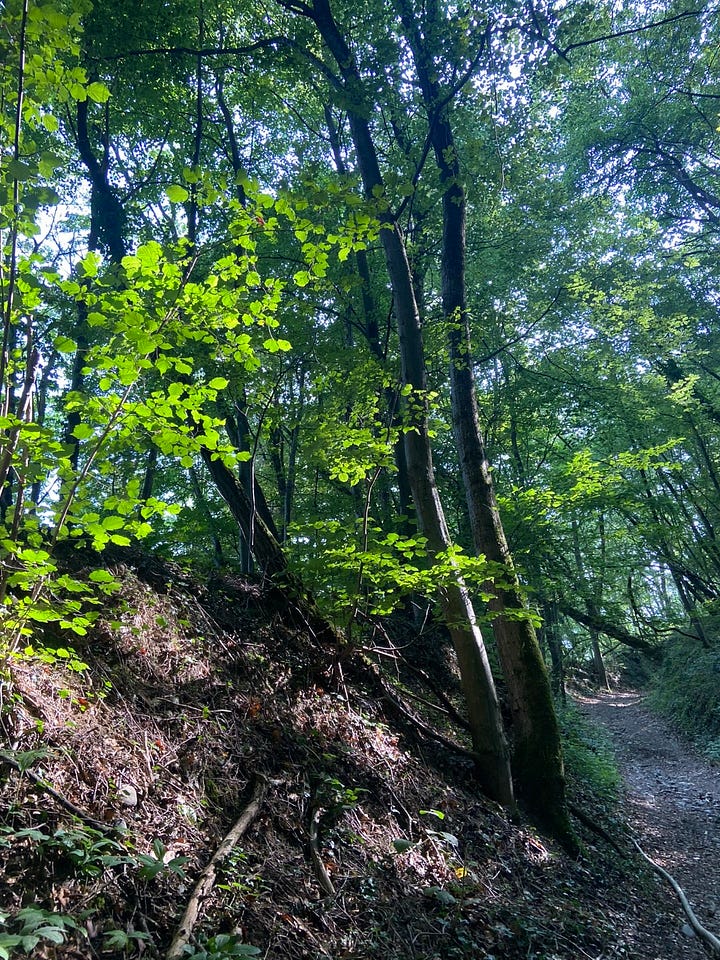

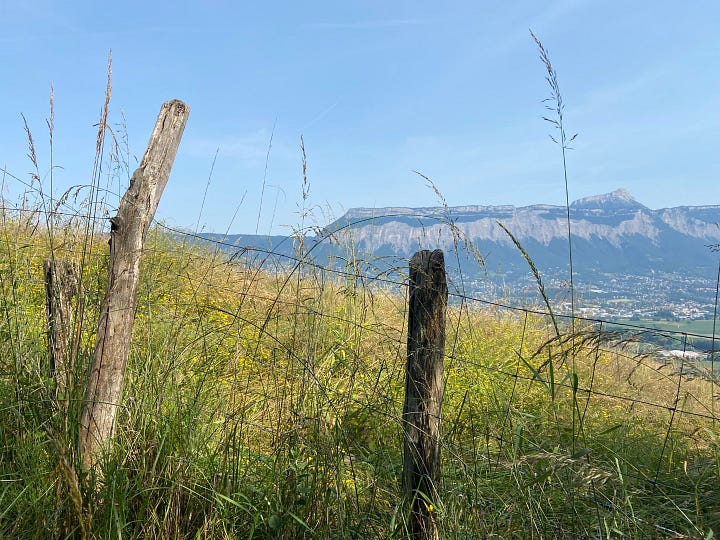
The villages: often no more than a few residences and farm buildings crowded close along a bend in the road. A gray-haired farmer ambles quietly by with a pitchfork over his shoulder, an errant weed trailing from his hand. A hay loft is loosely enclosed by weathered gray slats, waiting for a wayfarer to steal a night’s sleep. A shaggy dog on a long chain regards us from the barnyard. There are geraniums in a cottage window box. Tiles have long been sliding off a corrugated outbuilding roof and the wooden door is centuries-warped, but the cobbled walls look solid enough. “It still does the job” seems like it could be the farmer’s motto here—ça fait encore le taff.
Bigger villages feel more like neighborhoods, winding roads of well-kept houses, occasionally interrupted by a pasture for goats or donkeys. Some houses are clearly getaways for well-off commuters. There is even a castle: le château de Venon, a Renaissance-era miniature stronghold with a turret, a glimpse of courtyard, a deliciously old stone wall with ferns and succulents growing out of hollows left by fallen stones, rumors of medieval bishops and nuns; now it is (of course) an event venue—we can see a wedding reception being set up outside.

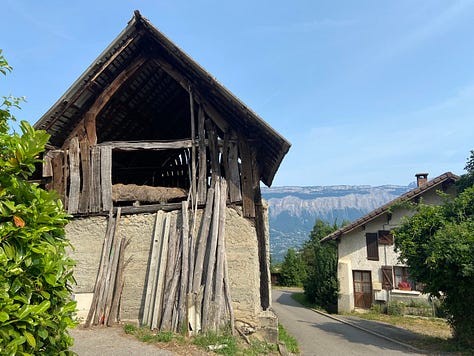


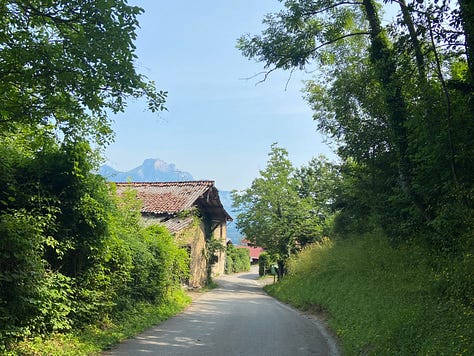
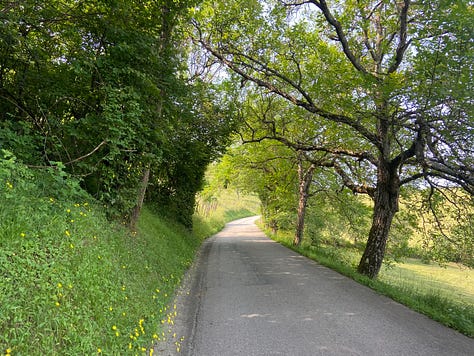
The pastures and cropland: As we try to decide if a field of green grain is wheat, rye, or barley, we hear the melodious tumbling of cowbells, and see the herd making its way from one patch of hummocked grass to another on the next hill over. It’s an incredibly idyllic sound, filling the landscape with the finishing touch of tranquility for the pastorale. The chorus keeps us company as we pass the roadside walnut and lime trees, the tap dripping into a stone watering trough, the brown cow licking her half-grown calf under a corrugated iron shelter, the wild orchids and yellow asters on the verges, the plastic-sheeted cylinders of hay.
For my postdoc research, I’m working with maps of alternative futures for land use in the Alps. Among other categories, the maps include forest, cropland, and pasture. Each map represents a different possible implementation of conservation goals in Europe based on different ways of valuing nature: “Nature for Nature,” “Nature for Society,” and “Nature as Culture.” Whereas Nature for Nature prioritizes habitat for promoting biodiversity and Nature for Society emphasizes carbon sequestration and other ecosystem services, that last category sees landscapes like these pastures as a cultural asset to preserve. Human livelihood as part of the ecosystem: without the grazing and mowing, forest would take over. John Muir called sheep in the Sierra Nevada “locusts with hooves,” but in Europe they’re considered by some guardians of grassland. I’m still adjusting to this way of seeing the landscape, the human presence as an integral one, the “modified” ecosystem as the desired one. I’m learning where there might be give and take.
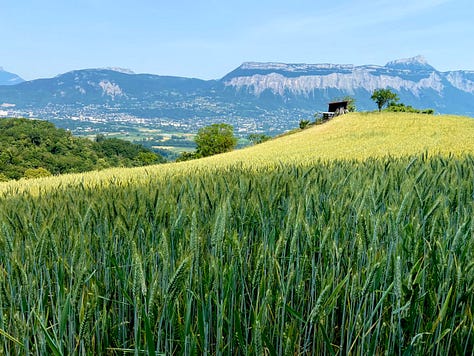
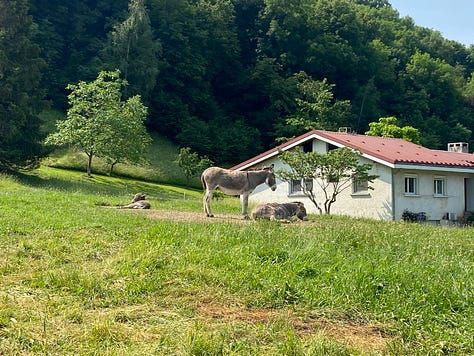

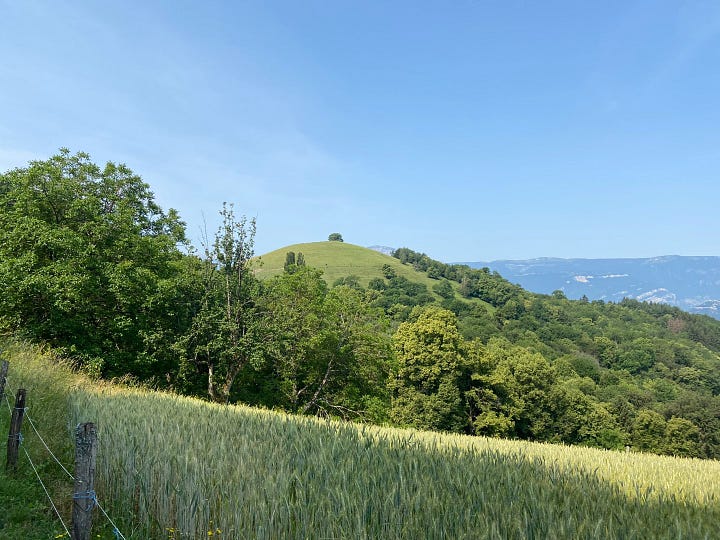
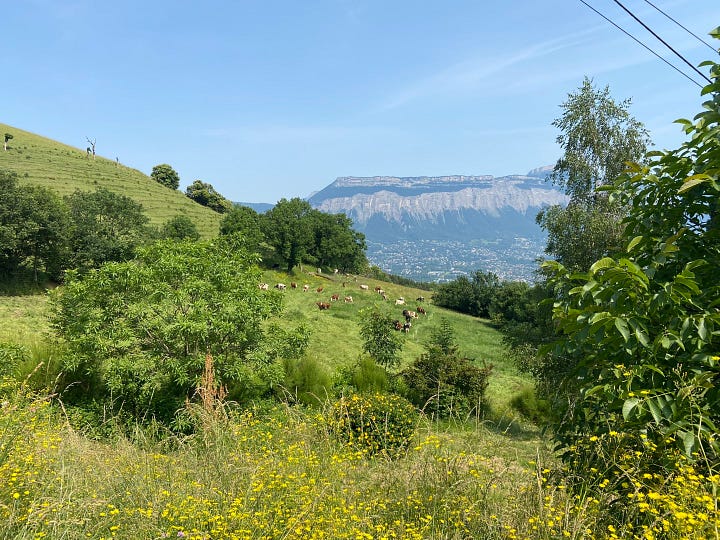
The tree: we could already see the hill when the cowbells started. Now we wind our way up and around, stepping over cow patties, and there it is: the spreading branches against the blue sky and the valley view, alone except for the gaggle of people standing under it. The wavy-edged leaves are still dense and summer-green. The bark is craggy and lichenous, split with its own weight. It’s survived at least two lightning strikes, the feet and carving knives of tourists, the fungus digesting its deadwood. It’s now sponsored by the tourist bureau of Isère and (of all things) its partnership with FairTrade Coffee. L'arbre le plus photographié des Alpes françaises.3
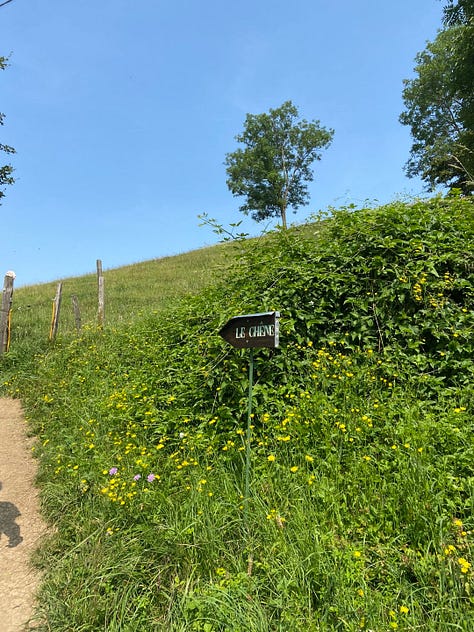
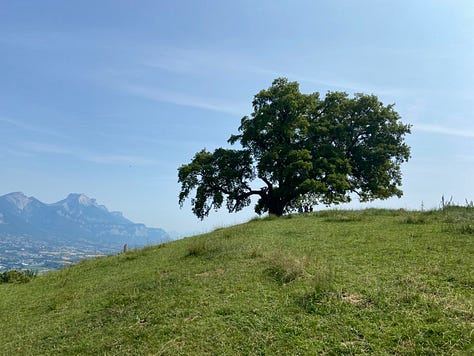

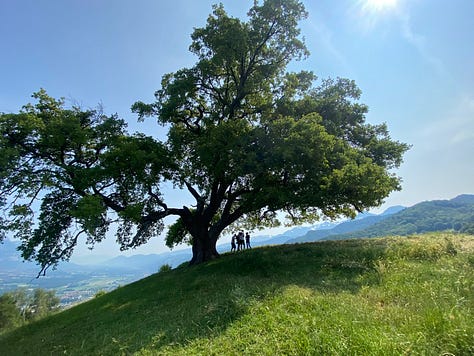

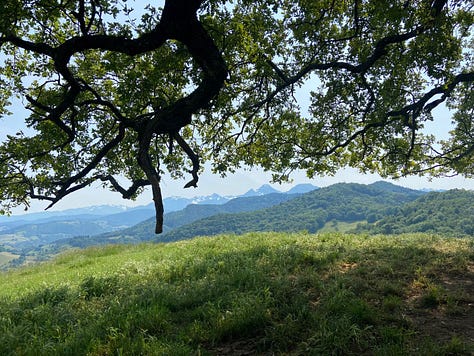
No one seems to know who planted le chêne, some 300 years ago, or why. Maybe it was for shade for the cows, or maybe it was for the birds and the wasps and the fungi and the squirrels. Maybe it was to stand like a beacon between the valley and the mountain. Maybe it was to leave behind a living message: I, too, was here on this hill.
Eighth wonder of the Dauphiné region
The Rockies are certainly subject to development, but not in the same long-ingrained, low-intensity way, and the native people who lived there before the arrival of European settlers managed to be less obvious about it than either culture.
The most photographed tree in the French Alps




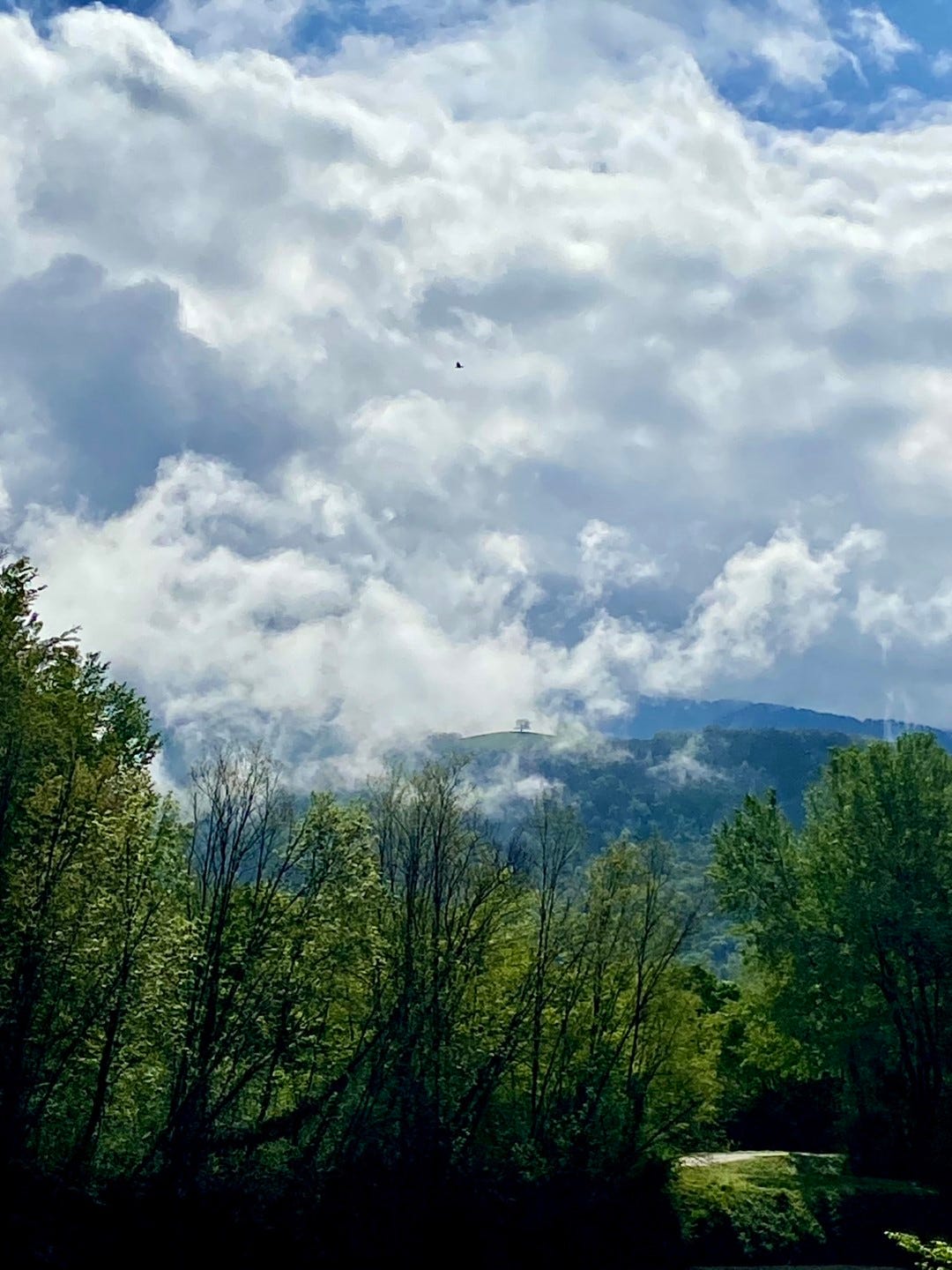
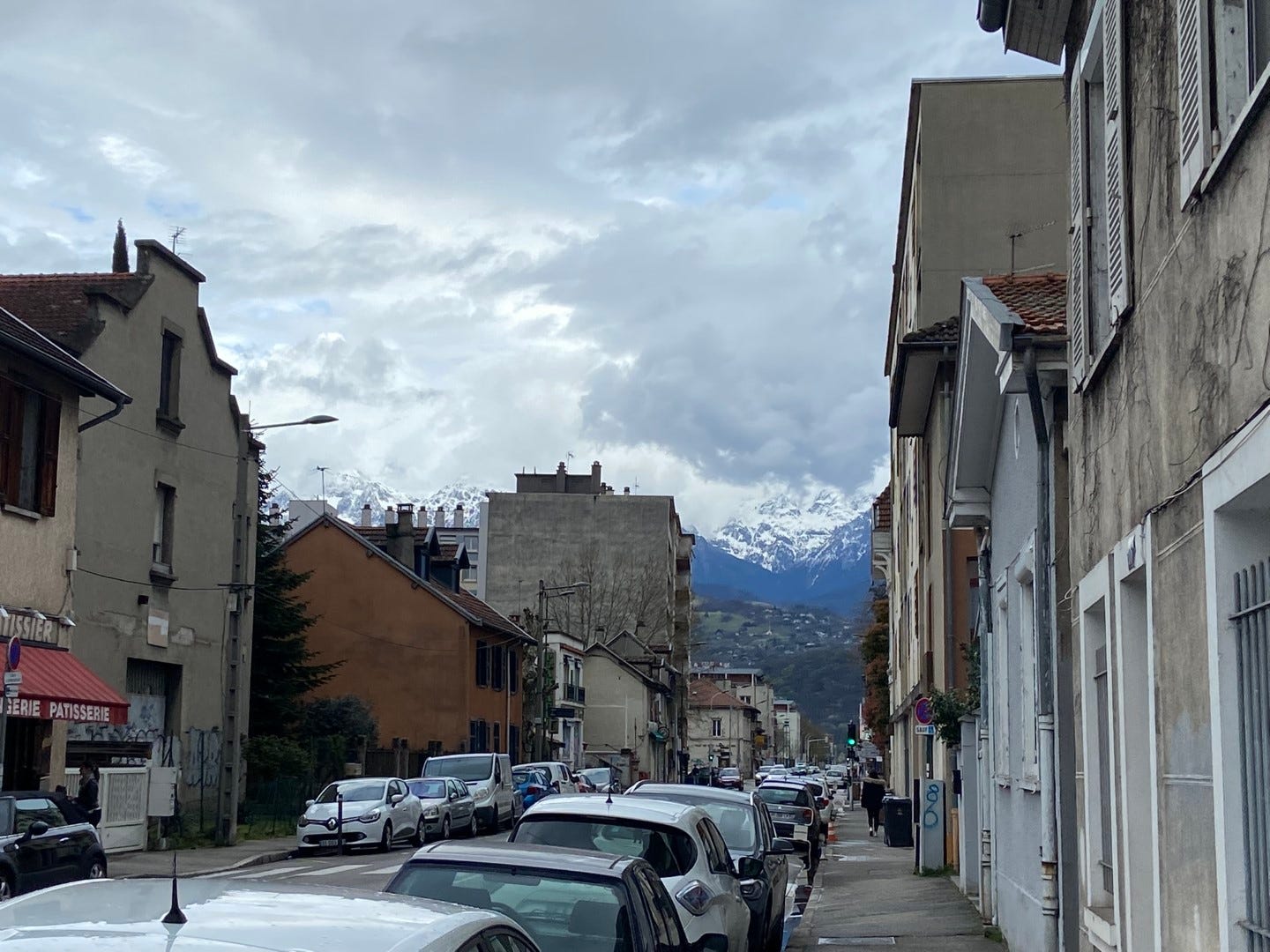

I really enjoyed this. Stuck indoors just now after complications during cataract surgery, and walking virtually through your posts. The chêne reminded me of the sycamore at Hadrian's Wall, which was cut down - vandalised - recently. From the outpouring of anger there seems to be a deep human connection to the "lone tree" in the landscape. There were also people saying "why don't we value all nature more, and not just when an Instagram-pretty tree is lost?". Very true.
Really fascinating to read about your research. Such an important area. I feel sorry that my own research didn't make any contribution to nature or humankind. "Memory and Imagination in the works of Proust and Flaubert" hasn't improved anyone's life 😂
P.S. I loved that video! Those two poplar(?) trees were huge!, and that pan over the section of mountian-range was certainly an eye-opening perspective on the general setting of Grenoble.